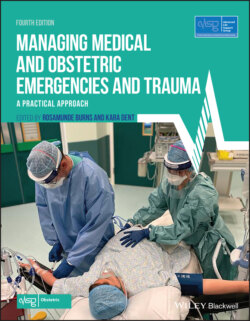Читать книгу Managing Medical and Obstetric Emergencies and Trauma - Группа авторов - Страница 119
Recognition of hypovolaemia
ОглавлениеMaternal blood loss can be categorised into four classes of severity, as shown in Table 6.1 and graphically in Figure 6.2.
To remember the different percentages in these classes of blood loss, think of the way of scoring in a tennis match!
Figure 6.2 illustrates the various clinical signs seen in ongoing acute blood loss suffered by a pregnant woman related to the volume lost. The point where the pulse rate is a higher number than the systolic blood pressure is a sign of significant decompensation.
Table 6.1 Severity of blood loss during maternal haemorrhage
| Class | Loss of circulating volume (%) | Blood loss in a 70 kg pregnant woman (ml) | Signs and symptoms |
|---|---|---|---|
| I | 0–15 | <1000 | Fully compensated due to blood diversion from the splanchnic pool. No symptoms. Minimal tachycardia is likely to be the only abnormal sign. No treatment needed in an otherwise healthy woman as long as the bleeding has stopped |
| II | 15–30 | 1000–2000 | Peripheral vasoconstriction maintains systolic blood pressure. The woman may be aware of increased heart rate and may display agitation or aggression. Narrowed pulse pressure and tachypnoea are the keys to early detection, as heart rate is only modestly increased and systolic blood pressure remains normal. Peripheral vasoconstriction maintains blood pressure. Requires crystalloid fluid replacement |
| III | 30–40 | 2000–2700 | Cardiovascular system shows signs of decompensation. The woman will look unwell. Tachycardia, tachypnoea, changes in mental status, fall in systolic blood pressure. Will require crystalloid and potential blood transfusion |
| IV | >40 | >2700 | Immediately life threatening. Tachycardia, fall in blood pressure, altered mental status, evidence of negligible urine output. Loss of >50% results in loss of consciousness, requiring immediate ‐surgery as well as massive transfusion |
Figure 6.2 Clinical parameters following increasing blood loss in the pregnant and postpartum woman
